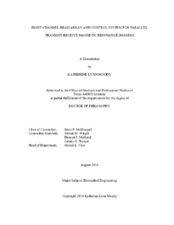| dc.description.abstract | Interest in magnetic resonance imaging (MRI) at high fields strengths (3 Tesla and above) is driven by the associated improvements in signal-to-noise ratio and spectral resolution. In practice, however, technical challenges prevent these benefits from being straightforwardly realized. High fields are associated with an increase in frequency and a decrease in the radiofrequency (RF) wavelength. The shortened wavelength causes potential inhomogeneity in the transmit field of the RF coil, resulting in non-uniform excitations. Susceptibility effects are also more pronounced at high field strengths, and can cause local distortions in the field and create areas of signal dropout.
Parallel transmit is one method in development to address these challenges at high fields. Parallel transmit involves using multiple independently driven channels with RF pulses varying in amplitude, phase, and pulse envelope to create desired transmit excitations. Parallel transmit has been implemented to create homogenous transmit patterns and compensate for magnetic susceptibility effects, but despite its proven usefulness, the technology has yet to receive widespread adoption. Few parallel transmit systems exist and little work has been done in the pre-clinical realm. Studies demonstrating the clinical benefits of parallel transmit constitute a gap in the current body of work. This works presents an approach to a parallel transmit array and control system that can be easily and safely integrated on a clinical whole-body scanner. The transmit array was designed for use with ultra-low output impedance amplifiers and demonstrates an array design with a simplified decoupling network augmented by amplifier decoupling in both transmit and receive. The control system was programmed in LabVIEW using off-the-shelf hardware to manage pulse playback, correct transmit chain non-linearities, monitor on-coil waveforms, and drive the transmit hardware. The transmit array was shown with well-isolated patterns, and parallel transmit capability was demonstrated. This work progressed the translation of experimental parallel transmit technology to pre-clinical use. | en |


